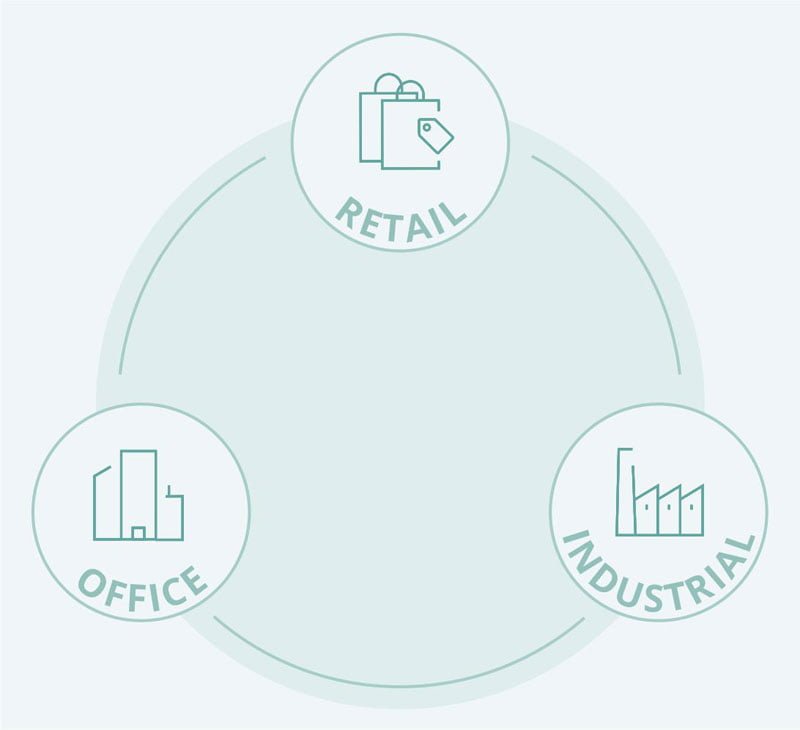The year 2022 has been one of recovery, with no major surprises on the Covid-19 front. During 2022, despite the ongoing economic concerns, the real estate sector performed well and witnessed higher traction. Peering into 2023, the year has started on some caution with pressures from a looming global recession and slowdown in certain sectors. While some sectors such as office are seeing slowing demand, there are ample opportunities in sectors such as industrial, alternate assets, etc. that are likely to grab stakeholders’ interest.
Office

Some polarisation in demand likely
The year 2022 saw record office leasing as the total leasing crossed 50 mn sq ft. However, the leasing was largely due to pent-up demand from the last two years and a recovery in demand. During 2023, we expect a relative slowdown in overall traction due to retrenchment in the technology sector and lower appetite for commercial real estate, amidst a looming global recession.
Nevertheless, certain established micro markets across the top six cities* such as BKC and Andheri in Mumbai, ORR and Whitefield in Bengaluru shall continue to see traction as these locations have an established ecosystem, wherein large corporates prefer to expand.

High focus on retrofitting; developers’ upgradation to give long-term benefits
With rapidly changing expectations of occupiers and rising focus on Environment and Social (E&S) compliance, there is massive opportunity for landlords and developers to upgrade outdated office assets. The top six cities have Grade A office buildings of about 120 mn sq ft that can be refurbished.
During 2023, there is likely to be greater activity from developers towards improving building efficiency, design adequacy and building sustainability criteria. These upgradations will provide long-term benefits and help assets remain competitive in the market.
While occupiers may shy away from large-scale upgradations, entailing larger capex during current times, investing in such upgradations might fetch them intangible benefits like improved employee productivity and better prospects at attracting talent.
Hybrid model to evolve, become more efficient
While 2022 was the year when hybrid working model picked up pace, the year 2023 would see occupiers creating policies to further define hybrid work.
Occupiers will focus on integrating CRE with HR and IT departments to make hybrid working more efficient and make collaboration seamless.
As per a survey done by Colliers on Hybrid working in September 2022, 63% of the occupiers in India are currently embracing hybrid mode and are likely to continue with hybrid working arrangements with employees coming to the office for 2-3 days a week.

Subdued leasing by tech companies; however sector’s take up in flex spaces to increase
So far, the technology sector has been the numero uno for office sector demand in the country. However, the year 2022 saw a drop in share of demand by tech players by about 6pp. Led by ongoing layoffs in the tech sector, the year 2023 might see a further slowdown in demand from the tech sector, especially for traditional office spaces. Despite this, we expect the share of demand by tech companies in flex spaces to shoot up.
Owing to the recessionary concerns, ongoing layoffs and uncertainty, flex spaces are likely to be tech occupiers’ preferred option since they offer flexible leasing terms.
The year 2022, saw highest flex space leasing of all time with 7 mn sq ft of gross leasing Pan India.
More green properties to enter the market
According to Colliers, the stock of green certified buildings has witnessed a 5-fold increase in 2022 compared to 2010. As a part of their short-term goals on ESG, listed developers target to increase their green portfolio by about 25% by 2025-2030 and increase the use of renewable sources of energy.
About 58 mn sq ft of additional green grade A stock has received pre-certifications or are under discussion for green certification which is likely to come in the office markets of Hyderabad, Pune and Delhi NCR.
Industrial

Upcoming government policies like National Logistics Policy, DESH Bill to provide an impetus to the sector
Led by the supply chain disruptions during 2022, government regulations and policies target to build a seamless logistics network across the country. The National Logistics Policy (NLP) 2022 aims at bringing digital transformation in the logistics sector through an integrated digital logistics system that will connect businesses and resolve supply-chain constraints.
During 2023 and going ahead, a number of city hubs will be built as part of NLP 2022. The policy along with plans like GatiShakti is likely to improve connectivity across the country and optimize resource utilization through a tech-enabled ecosystem, thus creating more demand for the sector especially through 3PL companies.
The proposed DESH Bill envisions to create development hubs to boost domestic manufacturing that will be World Trade Organisation – compliant. The attractive incentives offered by the DESH Bill is likely to attract a wide range of companies to operate in such hubs and boost demand for the region.
Growth of pure play e-commerce companies to stabilize; engineering and electronics sectors to see activity
While there was a rapid growth of e-commerce companies during the pandemic, the sector observed a slowdown during 2022. Leasing by e-commerce players saw a 79% YoY drop in 2022. Demand from e-commerce players is likely to remain inert in the coming quarters.
During 2023, while demand from 3PL companies is expected to remain intact, the demand from engineering and electronics companies is likely to further accelerate, as consumption levels are rising and supply chain bottlenecks have now relatively eased out.
Further, the rising vigour of ‘China plus one’ strategy will encourage global companies to shift some of their manufacturing capabilities to India.
Increased demand for q-commerce to fuel demand for micro-warehouses/dark stores
Demand for faster deliveries has seen a rise especially by q-commerce players who plan to move closer to end users. Led by this, there has been an increase in demand for storage requirements for small fulfilment centers within the city, which typically require 3-5 times less space than a regular warehouse.
During 2023, large q-commerce players are expected to focus more on expansion of dark stores in key hubs in cities led by increased demand for quick deliveries. Rise in number of dark stores will lead to higher scale of operations, which in turn would lead to higher demand for hub warehouses.

Electric Vehicles (EV) to gain more traction led by incentives for battery manufacturing announced during budget
The demand for EV during 2022 surged more than 3-folds1 compared to 2021, as faster adoption of EVs can cut down the need for fossil-fuel-run vehicles.
Led by various incentives announced in the recent budget for battery manufacturing like tax benefits and concessional duty extension for another year, we expect battery manufacturing to pick pace in 2023.
We expect there would be significant land requirement during the next few years, to set up giga factories for battery manufacturing.

Growth in investment-led new Grade A industrial developments
Over the last few years, the industrial sector has seen significant investment platforms where global investors are partnering with Indian developers.
According to Colliers, platform deals of about USD2 bn have already been announced in 2022 for the industrial sector. Platforms will deploy these funds to develop greenfield assets or brownfield projects in the industrial sector over the next few years.
The newer developments are expected to be best in class warehousing structures with AI and IoT enabled warehouse monitoring and management systems to seamlessly dispatch orders, track them and evolve them into on-demand warehousing centres.
Investments

Green financing to make significant inroads
Green financing has ascended in the cards of both borrowers and lenders to foster green development in India. Announcements made during the budget 2023-24, laid emphasis on green growth and related incentives such as green credit programme that can aid sustainable development.
During 2023, green financing is likely to drive major investment decisions and increase investment opportunities as domestic and offshore investors seek good quality Grade A projects that are sustainable and ESG compliant.
REITs to expand to other asset classes like retail and industrial
REITs have ensured stable returns to unitholders, with yields in the range of 6-7%. Consistent returns and success of REITs for office market assets has laid a strong foundation for other asset classes as well.
India’s first public issue of retail REIT is likely to hit the markets in the first half of 2023.
Players in the industrial sector have also started amalgamating their portfolios as they have started eyeing Industrial REITs, buoyed by expansionary activity in this space.

Special Situations Credit to aid stuck projects
Post Covid-19, special situations credit has picked up to aid projects that got stuck due to liquidity issues.
Led by increased opportunity, during 2023, major banks are likely to collaborate with private equity firms to develop special situation platforms for different asset classes.
This will help in project completions and at the same time absolve investors of approval risks. However, there is ample room for more stringent reforms for such funding, which would also make it more attractive for investors.

Investors to diversify and deepen presence in alternate assets, but preference for core office assets continues
Investors are eyeing alternate asset classes in Indian real estate, as they look to diversify their portfolios through high yielding alternate assets such as data centres, life sciences, etc. During 2022, institutional investments in alternate asset classes touched USD0.9 bn jumping 4-folds since 2019. However, led by the recessionary concerns, we expect investors to be more cautious with investments in alternate assets as risks involved is relatively higher in such assets. On the other hand, with about 41% share in total investments during 2022, office assets continue to be a mainstay for investors, especially for global funds.
During 2023, we expect the investments’ momentum to continue, as the office sector will continue to be a long-term bet for investors.
AIFs are likely to play a bigger role in flexible funding
Alternate investment funds are privately-pooled investment vehicles for those who are looking to diversify and maximise portfolio to risk-adjusted returns. We expect greater traction from AIFs towards flexible funding.
Repayment towards AIF platforms can be scheduled and aligned as per developers’ cash flow, thus preventing asset-liability mismatch. Led by such benefits, developers are likely to increasingly opt for AIFs going ahead.
With rising demand, the quantum of investments made for category II AIFs as of June 2022 rose 44% YoY, as per SEBI2.
Source:
- https://vahan.parivahan.gov.in/vahan4dashboard/vahan/view/reportview.xhtml
- https://www.sebi.gov.in/statistics/1392982252002.html





